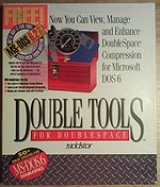
Double Tools for DoubleSpace
Encyclopedia
Double Tools for DoubleSpace is a software utility released in 1993 by the Menlo Park
Menlo Park, California
Menlo Park, California is a city at the eastern edge of San Mateo County, in the San Francisco Bay Area of California, in the United States. It is bordered by San Francisco Bay on the north and east; East Palo Alto, Palo Alto, and Stanford to the south; Atherton, North Fair Oaks, and Redwood City...
-based company Addstor, Inc. The utility functioned as an add-on to the disk compression
Disk compression
A disk compression software utility increases the amount of information that can be stored on a hard disk drive of given size. Unlike a file compression utility which compresses only specified files - and which requires the user designate the files to be compressed - a disk compression utility...
software DoubleSpace
DoubleSpace
DriveSpace is a disk compression utility supplied with MS-DOS starting from version 6.0. The purpose of DriveSpace is to increase the amount of data the user could store on disks, by transparently compressing and decompressing data on-the-fly. It is primarily intended for use with hard drives, but...
, supplied with MS-DOS 6.0
MS-DOS
MS-DOS is an operating system for x86-based personal computers. It was the most commonly used member of the DOS family of operating systems, and was the main operating system for IBM PC compatible personal computers during the 1980s to the mid 1990s, until it was gradually superseded by operating...
, adding a number of features not available in the standard version.
Features
Most of the Double Tools utilities worked from Microsoft WindowsMicrosoft Windows
Microsoft Windows is a series of operating systems produced by Microsoft.Microsoft introduced an operating environment named Windows on November 20, 1985 as an add-on to MS-DOS in response to the growing interest in graphical user interfaces . Microsoft Windows came to dominate the world's personal...
, providing a graphical view and control panel of the compressed drives on the computer (the utilities supplied with MS-DOS
MS-DOS
MS-DOS is an operating system for x86-based personal computers. It was the most commonly used member of the DOS family of operating systems, and was the main operating system for IBM PC compatible personal computers during the 1980s to the mid 1990s, until it was gradually superseded by operating...
only operated from DOS-mode). Double Tools also contained a number of disk checking and rescue/recovery utility. Some of the included utilities were called Silent Tools. One of the unique features of its time were the capability to defragment a DoubleSpace compressed drive in the background.
Some of the features, including the background defragmentation capability, required the user to let Double Tools replace the standard compression driver for MS-DOS (DBLSPACE.BIN) with one developed by Addstor, claimed to be 100% compatible with DoubleSpace and the Microsoft Real-Time Compression Interface introduced in MS-DOS 6.0 This driver added a number of extra features, such as the use of 32-bit
32-bit
The range of integer values that can be stored in 32 bits is 0 through 4,294,967,295. Hence, a processor with 32-bit memory addresses can directly access 4 GB of byte-addressable memory....
code paths when it detected a Intel 80386
Intel 80386
The Intel 80386, also known as the i386, or just 386, was a 32-bit microprocessor introduced by Intel in 1985. The first versions had 275,000 transistors and were used as the central processing unit of many workstations and high-end personal computers of the time...
or higher CPU, caching capabilities and - in addition to its supporting the use of the Upper Memory Area
Upper Memory Area
In DOS memory management, the upper memory area refers to memory between the addresses of 640 KB and 1024 KB in an IBM PC or compatible. IBM reserved the uppermost 384 KB of the 8088 CPU's 1024 KB address space for ROM, RAM on peripherals, and memory-mapped input/output...
- also permitted the use of Extended Memory
Extended memory
In DOS memory management, extended memory refers to memory above the first megabyte of address space in an IBM PC or compatible with an 80286 or later processor. The term is mainly used under the DOS and Windows operating systems...
for some of its buffers (reducing the driver's total footprint in conventional
Conventional memory
In DOS memory management, conventional memory, also called base memory, is the first 640 kilobytes of the memory on IBM PC or compatible systems. It is the read-write memory usable by the operating system and application programs...
and upper
Upper Memory Area
In DOS memory management, the upper memory area refers to memory between the addresses of 640 KB and 1024 KB in an IBM PC or compatible. IBM reserved the uppermost 384 KB of the 8088 CPU's 1024 KB address space for ROM, RAM on peripherals, and memory-mapped input/output...
memory, albeit at the cost of somewhat reduced speed).
Other features provided by Double Tools was the ability to have compressed removable media auto-mounted as they were used (instead of the user having to do this manually). This capability, however, was introduced with the standard version of DoubleSpace found in MS-DOS 6.2. However, Double Tools also had the capability to put a special utility on compressed floppy disks that made it possible to access the compressed data even on computers that didn't have DoubleSpace (or Double Tools).
Another interesting function was the ability to split a compressed volume over multiple floppy disks, being able to see the entire volume with only the first disk inserted (and being prompted to change discs as necessary). It was also possible to share a compressed volume with a remote computer.

